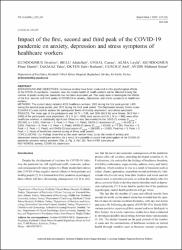| dc.contributor.author | Gündoğmuş, İbrahim | |
| dc.contributor.author | Bolu, Abdullah | |
| dc.contributor.author | Ünsal, Cansu | |
| dc.contributor.author | Alma, Leyla | |
| dc.contributor.author | Demir Gündoğmuş, Pınar | |
| dc.contributor.author | Takmaz, Taha | |
| dc.contributor.author | Ökten, Sabri Berkem | |
| dc.contributor.author | Gündüz, Anıl | |
| dc.contributor.author | Aydın, Mehmet Sinan | |
| dc.date.accessioned | 2023-11-10T07:22:06Z | |
| dc.date.available | 2023-11-10T07:22:06Z | |
| dc.date.issued | 2022 | en_US |
| dc.identifier.citation | Gündoğmuş İ, Bolu A, Ünsal C, Alma L, Demir Gündoğmuş P, Takmaz T, Ökten SB, Gündüz A, Aydın MS. Impact of the first, second and third peak of the COVID-19 pandemic on anxiety, depression and stress symptoms of healthcare workers. Bratislava Medical Journal (2022): 123(11); 833-839. | en_US |
| dc.identifier.issn | 0006-9248 | |
| dc.identifier.uri | http://www.elis.sk/download_file.php?product_id=7815&session_id=vbik79ucgkactpobbjvjg2han1 | |
| dc.identifier.uri | https://doi.org/10.4149/BLL_2022_133 | |
| dc.identifier.uri | https://hdl.handle.net/20.500.12780/748 | |
| dc.description.abstract | BACKGROUND AND OBJECTIVES: Numerous studies have been conducted on the psychological effects
of the COVID-19 pandemic. However, how the mental health of health workers will be affected among the
number of peaks during the pandemic has not been evaluated yet. The study aims to investigate the effects
of the fi rst, second, and third peaks of COVID-19 on anxiety, depression, and stress symptoms in healthcare
workers.
METHODS: The current study included 4031 healthcare workers, 1051 during the fi rst peak period, 1409
during the second peak period, and 1571 during the third peak period. The Depression Anxiety Stress scale 21(DASS-21) was used to assess the participants’ levels of anxiety, depression, and stress symptoms.
RESULTS: The mean age of the participants was 33.74 ± 7.95, and 2634 (66.3 %) were female. 36.9 %(n =
1486) of the participants were physicians, 41.1 % (n = 1655) were nurses and 22.1 % (n = 890) were other
healthcare workers. A statistically signifi cant difference was documented in the DASS-21 anxiety (F(2:4028) =
502.893, p < 0.001, Post-hoc = 3. Peak > 2. Peak > 1. Peak), DASS-21 depression (F(2:4028) = 46.034, p <
0.001, Post-hoc = 3. Peak > 2. Peak > 1. Peak), DASS-21 stress (F(2:4028) = 65.548, p < 0.001, Post-hoc = 3.
Peak = 2. Peak > 1. Peak), and DASS-21 total scores (F(2:4028) = 156.860, p < 0.001, Post-hoc = 3. Peak > 2.
Peak > 1. Peak) of healthcare workers during all three peak periods.
CONCLUSIONS: Our fi ndings show that as the peak number rises, so do the levels of anxiety and
depression among healthcare workers. As a result, it is possible to assert that prolongation of the COVID-19
pandemic worsens mental problems. | en_US |
| dc.language.iso | eng | en_US |
| dc.publisher | Slovak Academic Press | en_US |
| dc.relation.isversionof | 10.4149/BLL_2022_133 | en_US |
| dc.rights | info:eu-repo/semantics/openAccess | en_US |
| dc.subject | Anxiety | en_US |
| dc.subject | Covid-19 | en_US |
| dc.subject | Depression | en_US |
| dc.title | Impact of the first, second and third peak of the COVID-19 pandemic on anxiety, depression and stress symptoms of healthcare workers | en_US |
| dc.type | article | en_US |
| dc.contributor.department | İstanbul Kent Üniversitesi, Fakülteler, İnsan ve Toplum Bilimleri Fakültesi, Psikoloji Bölümü | en_US |
| dc.contributor.authorID | https://orcid.org/0000-0002-5159-238X | en_US |
| dc.contributor.institutionauthor | Gündüz, Anıl | |
| dc.identifier.volume | 123 | en_US |
| dc.identifier.issue | 11 | en_US |
| dc.identifier.startpage | 833 | en_US |
| dc.identifier.endpage | 839 | en_US |
| dc.relation.journal | Bratislava Medical Journal | en_US |
| dc.relation.publicationcategory | Makale - Uluslararası Hakemli Dergi - Kurum Öğretim Elemanı | en_US |


















